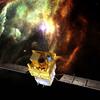You are here
Largest-ever digital camera set to scan the Universe
07.12.2024, by
It took hundreds of scientists worldwide, including several CNRS teams, to produce the world’s largest digital camera, the LSST (Legacy Survey of Space and Time), which has finally arrived in Chile. Mounted on the telescope at the Vera C. Rubin Observatory, it will scan the southern sky in order to investigate and map the Universe, determine the nature of dark energy and dark matter, and even detect any asteroids that might pose a threat to our planet.
To find out more
The world's largest digital camera for astronomy will soon be ready to observe the sky
The Film of our Universe (video)

1
Slideshow mode
On 16 May, 2024, after enduring several tens of kilometres of dirt track across the Andes, the largest digital camera ever assembled reaches its final destination, the Vera C. Rubin Observatory, atop the mountain Cerro Pachón.
Travis Lange / SLAC National Accelerator Laboratory

2
Slideshow mode
Deep inside the LSST camera the interior of the cryostat keeps the various components at a low temperature in order to avoid noise in the images captured. The sensors making up the focal plane of the camera will then be mounted on the grid.
Andy Freeberg / SLAC National Accelerator Laboratory

3
Slideshow mode
The camera, whose focal plane employs a mosaic of 189 16-megapixel CCD sensors, will capture images each made up of 3.2 billion pixels. Every 40 seconds, i.e. 800 times a night, it will take a photograph of the sky covering an area equal to that of 40 full moons. The pictures will be of such high quality that scientists will be able to observe very faint, and therefore very distant, astronomical objects with unprecedented precision.
Jacqueline Ramseyer Orrell / SLAC National Accelerator Laboratory

4
Slideshow mode
Some ten CNRS laboratories were involved in the design of the huge instrument, and in particular of its filter-changing mechanism. This robotic system will capture images of the sky through six different colour filters, ranging from ultraviolet to infrared. By studying the light emitted by celestial objects in these six colours, it will be possible to determine their distance from the Earth.
Olivier Bonin / SLAC National Accelerator Laboratory

5
Slideshow mode
The size of a small car and weighing nearly three tonnes, this unique camera will produce an unprecedented volume of data on a daily basis. In fact, the scientists expect to collect the equivalent of 20 terabytes of material in the form of images every night. Three processing centres will be involved in analysing the images: one, managed by CNRS Nuclear & Particles, is located in Lyon (southeastern France), while the other two are based in the US and the UK.
Jacqueline Ramseyer Orrell / SLAC National Accelerator Laboratory

6
Slideshow mode
All the camera components were assembled at the Stanford Linear Accelerator Center (SLAC) in California (USA). After long months of testing, they were carefully packed and then secured in a container to be flown to Chile.
Jacqueline Ramseyer Orrell / SLAC National Accelerator Laboratory

7
Slideshow mode
An Atlas Air cargo plane, specially designed to carry exceptional cargo over long distances, was chartered to transport the giant camera to Chile's capital, Santiago.
Olivier Bonin / SLAC National Accelerator Laboratory

8
Slideshow mode
Protected by a case, the camera finally arrives at the Vera C. Rubin Observatory. Immediately taken in hand by on-site engineers, it will be thoroughly checked to ensure it sustained no damage during transport, before being installed and connected to the telescope.
Olivier Bonin / SLAC National Accelerator Laboratory

9
Slideshow mode
The scientists will soon begin connecting the camera to the major component of the facility, a telescope with an 8.4 metre mirror. Together, they will track down and identify the dark bodies orbiting in the outer reaches of the Solar System, hopefully increasing our understanding of dark energy and dark matter.
Alexandre Boucaud / CNRS

10
Slideshow mode
It will take a few months to calibrate all the observatory's instruments before the astronomical survey itself actually begins, in the autumn of 2025. The Vera C. Rubin telescope's first light (i.e. the moment when the telescope collects its first photons) is expected in early 2025.
Olivier Bonin / SLAC National Accelerator Laboratory








